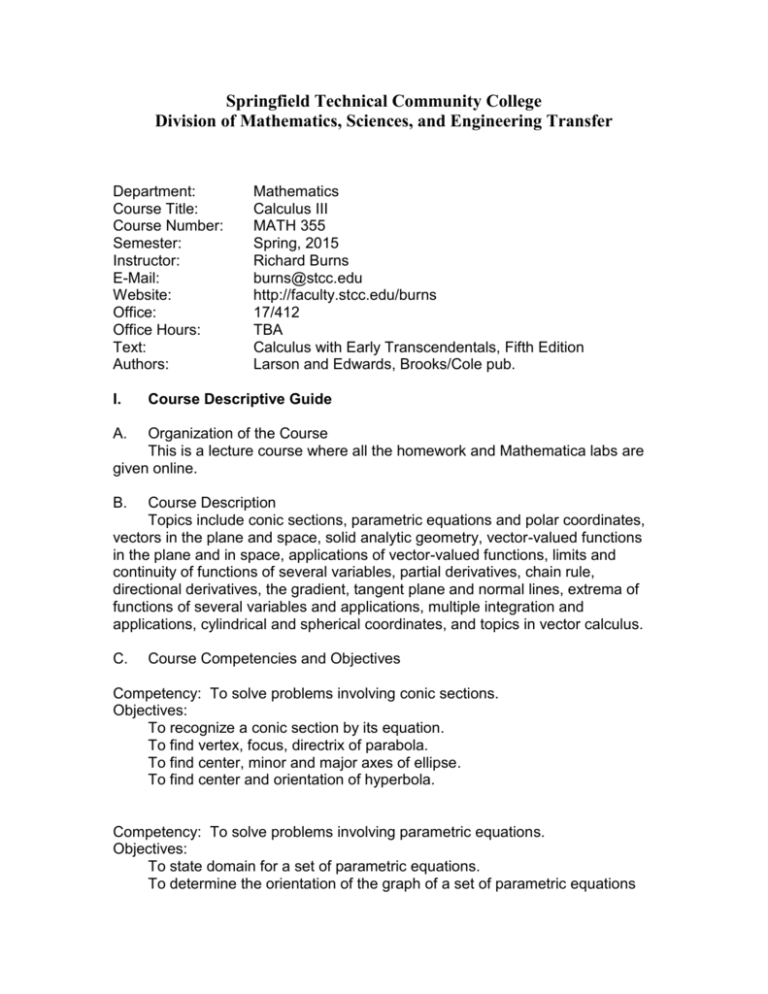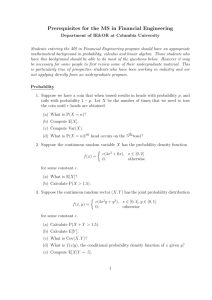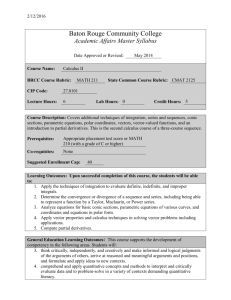355syllabus-mat233 - Springfield Technical Community College
advertisement

Springfield Technical Community College Division of Mathematics, Sciences, and Engineering Transfer Department: Course Title: Course Number: Semester: Instructor: E-Mail: Website: Office: Office Hours: Text: Authors: I. Mathematics Calculus III MATH 355 Spring, 2015 Richard Burns burns@stcc.edu http://faculty.stcc.edu/burns 17/412 TBA Calculus with Early Transcendentals, Fifth Edition Larson and Edwards, Brooks/Cole pub. Course Descriptive Guide A. Organization of the Course This is a lecture course where all the homework and Mathematica labs are given online. B. Course Description Topics include conic sections, parametric equations and polar coordinates, vectors in the plane and space, solid analytic geometry, vector-valued functions in the plane and in space, applications of vector-valued functions, limits and continuity of functions of several variables, partial derivatives, chain rule, directional derivatives, the gradient, tangent plane and normal lines, extrema of functions of several variables and applications, multiple integration and applications, cylindrical and spherical coordinates, and topics in vector calculus. C. Course Competencies and Objectives Competency: To solve problems involving conic sections. Objectives: To recognize a conic section by its equation. To find vertex, focus, directrix of parabola. To find center, minor and major axes of ellipse. To find center and orientation of hyperbola. Competency: To solve problems involving parametric equations. Objectives: To state domain for a set of parametric equations. To determine the orientation of the graph of a set of parametric equations To sketch the graph of a set of parametric equations. To eliminate the parameter from a set of parametric equations. To find a set of parametric equations for a given equation. To compute the first and second derivative for a set of parametric equations. Competency: To solve problems involving parametric equation. Objectives: To compute the slope of line tangent to graph of a set of parametric equations. To find an equation of the line tangent to the graph of a set of parametric equations. To compute the length of an arc determined by a set of parametric equations. Competency: To solve problems involving polar coordinates. Objectives: To plot points in polar coordinates. To convert equations from rectangular form to polar form. To convert equations from polar form to rectangular form. To test for symmetry in polar coordinates. To sketch the graph of a polar function. To identify special polar forms and sketch their graph. To compute all vertical and horizontal tangents to polar graphs. To compute points of intersection of polar graphs. To compute the area of regions bounded by one or more polar functions. To compute the length of an arc determine by a polar function. Competency: To solve problems involving vectors in the plane. Objectives: To state the definition of the special unit vectors. To express a vector in component form using the special unit vectors. To plot a vector given in rectangular form. To plot a vector given in polar form. To convert a vector from rectangular form to polar form. To convert a vector from polar form to rectangular form. To add two vectors mathematically and graphically. To perform scalar multiplication mathematically and graphically. To compute the length of a vector. To compute the unit vector in the direction of a given vector. To compute the scalar (dot) product of two vectors. To state and prove the properties of the dot product. To determine if two vectors are orthogonal. To compute the projection of one vector onto another. To evaluate and plot vector-valued functions. To compute the limit of vector-valued functions. To discuss the continuity of a vector-valued function. To apply the definition of the derivative to a vector-valued function. To explain graphically the meaning of the derivative of a vector-valued function. To compute the derivative of vector-valued functions. To state and derive the properties of the derivative of a vector-valued function. To compute the vector tangent to the path of a vector-valued function. To compute the integral of vector-valued functions. To compute the velocity and acceleration of a particle given its position. To compute the velocity and position of a particle given its acceleration. To apply the calculus of vector-valued functions to physics and engineering problems. To define and compute the unit tangent vector for a given vector-valued function. To define and compute the unit normal vector for a given vector-valued function.. To compute the tangential and normal components of an acceleration vector for a given vector-valued function. To compute curvature for a given vector-valued function. To compute radius and center of the circle of curvature for a given vectorvalued function. To plot the path, velocity vector, acceleration vector and its components, and circle of curvature associated with a given vector-valued function at a given point. Competency: To solve problems involving vectors in space. Objectives: To derive and apply the distance formula. To compute the direction cosines for a line or vector in space. To decompose a vector in space into components. To define and apply the cross product for two vectors. To state and derive the properties of the cross product. To compute the scalar triple product of three vectors. To compute areas using the cross product. To compute volumes using the scalar triple product. To write the parametric forms for the line passing through two points. To write the symmetric forms for the line passing through two points. To write an equation of the line satisfying specified conditions. To determine if two lines are parallel or skew. To determine the point of intersection of two lines. To write an equation of the plane passing through three non-collinear points. To write an equation of the plane satisfying specified conditions. To compute the distance between a point and a plane. To compute the distance between a point and a line. To compute the distance between a line and a plane. To compute the distance between two parallel lines. To compute the distance between skew lines. To identify and sketch cylindrical surfaces. To identify and sketch certain quadratic surfaces. To define and sketch space curves. To evaluate and sketch certain vector-valued functions in space. To compute the length of an arc of a space curve. To compute the velocity and acceleration given the position function for a particle in space. To compute the tangent and normal vectors for a position function. To compute the tangential and normal components of acceleration for a particle in space. To compute the curvature for a space curve. Competency: To solve problems involving functions of several variables. Objectives: To define and evaluate a function of several variables. To state the domain and range of a function of several variables. To sketch the graph for a function of two variables. To sketch the level curves associated with a function of two variables. To sketch the level surfaces associated with a function of three variables. To compute the limit of a function of two variables. To discuss the continuity of a function of two variables. To state and apply the definition of partial derivative. To compute the partial derivatives of a function of several variables. To compute higher order derivatives of functions of several variables. To state and apply the definition of total differential. To apply the concept of differentials to compute relative error. To apply the chain rule to compute the derivative of a function. To apply the concept of implicit differentiation to compute the derivatives of functions. To define and compute the directional derivative of a function. To define and compute the gradient of a function. To apply the concept of gradient to solve problems involving rates of change of a function. To find an equation for the plane tangent to a surface at a given point. To find an equation for a line normal to a surface at a given point. To compute the angle of inclination of a tangent plane. To state and apply the Extreme Value Theorem for a function of two variables. Competency: To solve problems involving functions of several variables. Objectives: To compute and classify critical points for a function of two variables. To compute the absolute extrema for a function of two variables. To solve applied extrema problems. Competency: To solve problems involving multiple integration. Objectives: To evaluate an iterated integral. To find areas using double integration in two ways. To switch the order of integration of a double integral. To compute volumes using double integration. To areas in polar coordinates using double integration. To change an integral from rectangular form to polar form. To change an integral from polar form to rectangular form. To apply double integration to compute mass, center of mass, and moment of inertia. To apply triple integration to compute volume, mass, center of mass, and moment of inertia. To convert triple integrals between systems (rectangular, cylindrical, and spherical) and evaluate. Competency: To solve problems involving vector calculus. Objectives: To define and sketch a vector field. To compute the curl of a vector field. To determine if a vector field is conservative. To compute the potential function for a conservative field. To compute the divergence of a vector field. To evaluate line integrals. To apply line integrals to compute work. To state and apply the Fundamental Theorem of Line Integrals. To list and apply the fundamental properties of a conservative field. To state and apply Green's Theorem. D. Evaluation Criteria If at any time during the semester there is evidence of a student using unauthorized material or submitting answers which are not of their own original composition on examinations, then that student will be dismissed from the course, receive a grade of F for the semester, and be referred to the Dean of Students for further action. There will be six one-hour examinations and a cumulative final examination, which will be valued as two hour examinations. Homework is online on the webassign.net site and is counted as 10% of the grade. There are six Mathematica labs that are given on webassign.net that count as one hour exam. Your grade will be calculated as follows: g = .9*( (t1 + t2 + t3 + t4 + t5 + t6 + lab + 2*final)/9 ) + .1*hw II. Course Outline Chapter 10: Plane Curves, Parametric Equations, and Polar Coordinates 10.1 Conic Sections 10.2 Plane Curves and Parametric Equations 10.3 Parametric Equations and Calculus 10.4 Polar Coordinates and Polar Graphs 10.5 Area and Arc Length in Polar Coordinates Examination 1 Chapter 11: Vectors and the Geometry of Space 11.1 Vectors in the Plane 11.2 Space Coordinates and Vectors in Space 11.3 The Dot Product of Two Vectors 11.4 The Cross Product of Two Vectors in Space 11.5 Lines and Planes in Space 11.6 Surfaces in Space 11.7 Cylindrical and Spherical Coordinates Examination 2 Chapter 12: Vector-valued Functions 12.1 Vector-valued Functions 12.2 Derivatives of Vectors in Space 12.3 Velocity and Acceleration 12.4 Tangent Vectors, Normal Vectors 12.5 Arc Length and Curvature Examination 3 Chapter 13: Functions of Several Variables 13.1 Introduction to Functions of Several Variables 13.2 Limits and Continuity 13.3 Partial Derivatives 13.4 Differentials 13.5 Chain Rules for Functions of Several Variables 13.6 Directional Derivatives and gradients 13.7 Tangent Planes and Normal Lines 13.8 Extrema of Functions of Several Variables 13.9 Applications of Extrema of Functions of Two Variables Examination 4 Chapter 14: Multiple Integration 14.1 14.2 14.3 14.4 14.6 14.7 Iterated Integrals and Area in the Plane Double Integrals and Volume Change of Variables: Polar Coordinates Center of Mass and Moments of Inertia Triple Integrals and Applications Triple Integrals in Cylindrical and Spherical Coordinates Examination 5 Chapter 15: Vector Analysis 15.1 Vector Fields 15.2 Line Integrals 15.3 Conservative Vector Fields and Independence of Path 15.4 Green's Theorem Examination 6 Final Examination






